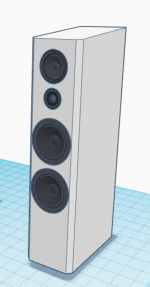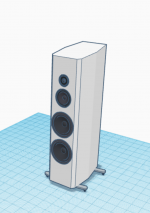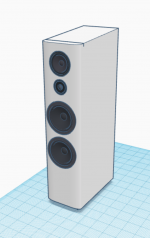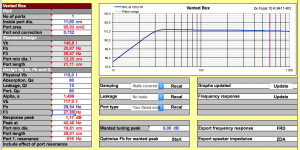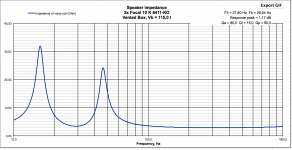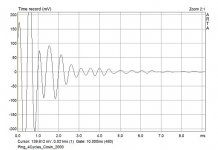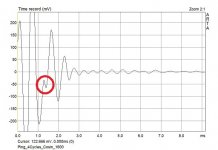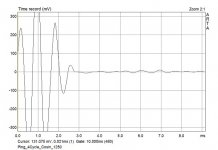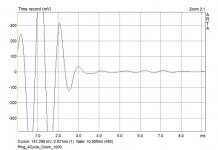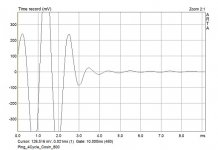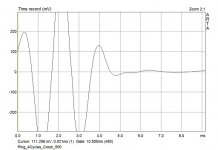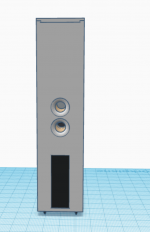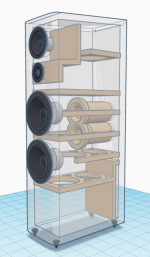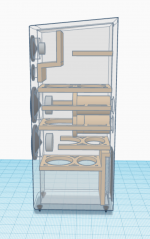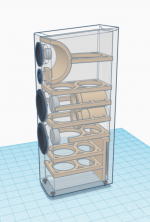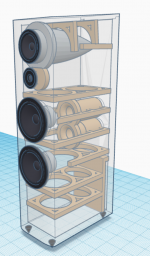Why don't you take a look at the Hypex Fusion amps? FA252 or FA253. State of the art, simple to operate. I have built studio monitors with the SBA WO24, Volt VM752, SBA TW29DN-B. You won't be disappointed with the SBA drivers. I actively tuned them flat to 20hz and it is nothing short of amazing.
The FA123 is also a fusion amp. And why should I consider the 252 at all for my three-way speakers? And why the 253? It's no different from the 123 except it has even more power and is more expensive and the 123 already delivers more power than I could ever need so the 253 would just be a huge waste of money.
Hey guys, back at it again.
At what height would you suggest the middle point between the midrange and tweeter should be? I'm in a bit of a dilemma with aesthetics, acoustic centre and time alignment.
You know how I was talking about the Tidal speakers? They have those pyramid shaped edges and are tilted backwards for time alignment. I wanted to make something similar but I'm finding those pyramid edges hard to build and I still like the aesthetics of the midrange on top better, like on the Audio Physic Cardeas or Gamut RS7i or Zodiac (even though that's not the midrange).
Time alignment I can easily fix with the DSP of the Hypex amp but how about the acoustic centre. I often see very good and beautiful speakers with the midrange on top but aren't that high to get the tweeter above 1 m (my ear height is between 1 and 1,1 m depending on the chair or couch I'm sitting on) like the Kroma Audio Carmen, Audio Solutions Figaro M or L or KEF Reference but then Focal Kanta and Sopra Nº3, Canton Reference 1K, Rockport Technologies Lyra, Magico M6 and probably more are big enough to get the tweeter well above 1 m.
Do you think the sound will be high enough with the midrange on top? The middle point between the tweeter and midrange in the cabinet is at about 1,07 m but the middle of the tweeter at only about 0,97 m.
with the midrange on top it will be good looking without the pyramid shaped edges so it won't have the acoustical advantage anymore but I will still make slanted edges so there's still something and it's much easier to build.
Do you think it will be to much of a drawback or will it be okay? I mean, there also is a lol of very good speakers that don't have the pyramid shaped edges.
At what height would you suggest the middle point between the midrange and tweeter should be? I'm in a bit of a dilemma with aesthetics, acoustic centre and time alignment.
You know how I was talking about the Tidal speakers? They have those pyramid shaped edges and are tilted backwards for time alignment. I wanted to make something similar but I'm finding those pyramid edges hard to build and I still like the aesthetics of the midrange on top better, like on the Audio Physic Cardeas or Gamut RS7i or Zodiac (even though that's not the midrange).
Time alignment I can easily fix with the DSP of the Hypex amp but how about the acoustic centre. I often see very good and beautiful speakers with the midrange on top but aren't that high to get the tweeter above 1 m (my ear height is between 1 and 1,1 m depending on the chair or couch I'm sitting on) like the Kroma Audio Carmen, Audio Solutions Figaro M or L or KEF Reference but then Focal Kanta and Sopra Nº3, Canton Reference 1K, Rockport Technologies Lyra, Magico M6 and probably more are big enough to get the tweeter well above 1 m.
Do you think the sound will be high enough with the midrange on top? The middle point between the tweeter and midrange in the cabinet is at about 1,07 m but the middle of the tweeter at only about 0,97 m.
with the midrange on top it will be good looking without the pyramid shaped edges so it won't have the acoustical advantage anymore but I will still make slanted edges so there's still something and it's much easier to build.
Do you think it will be to much of a drawback or will it be okay? I mean, there also is a lol of very good speakers that don't have the pyramid shaped edges.
Attachments
Hi guys, back at it again but now for real. I had a nearly worked out design inspired by the Vimberg Mino and it looked good but I've been to X-Fi today, the high-end audioshow in the Netherlands, and I've actually heard the Vimbergs but I didn't really like them, here I'm mainly talking about the highs. I know there is tons of other factors that determine how it will sound but the highs weren't focused enough, too far lay back for my liking. And again, I know there's tons of other factors but in general I found speakers with a midrange or mid woofer on top to sound better. Chattelin was there with both the Kroma Audio Carmen, Mimi and even Elektra, man those are amazing speakers and what a great job of integrating do the guys from Chattelin do. The only thing I found to sound better than those was the Avantgarde Acoustics Trio with Basshorn (yes they were there, yes they are insane) but that isn't a fair comparison. And another speaker which I found to sound very nice was the Audio Solutions Vantage, which also has the midrange on top. Those had the best imaging I've heard on the entire show. Even better than the Kroma's.
So now I'm determined to have the midrange on top and a normal vertical design with the drivers on the right height.
This is what I came up with. It's almost no different than the first design in this thread but I can easily make the rounded baffle because I've got contact with someone who has a milling machine. It's really, really big. I haven't enlarged the dimensions but I've designed it very space efficiently yet stiff with lots of bracing.
I have a little over 115 L of internal volume to my disposal which is a lot. What do you think would be the right tuning of the enclosure? Earlier in this thread someone said that I have to tune lower than the optimal F3 point to avoid boomyness but can't it be a little higher than the optimal as well? Below the optimal at the 62,5 watts per driver which the amps will offer the woofers will go over the Xmax and I know I'll almost never reach the full power but I don't want to immediately blow the woofers when I do.
What do you think?
So now I'm determined to have the midrange on top and a normal vertical design with the drivers on the right height.
This is what I came up with. It's almost no different than the first design in this thread but I can easily make the rounded baffle because I've got contact with someone who has a milling machine. It's really, really big. I haven't enlarged the dimensions but I've designed it very space efficiently yet stiff with lots of bracing.
I have a little over 115 L of internal volume to my disposal which is a lot. What do you think would be the right tuning of the enclosure? Earlier in this thread someone said that I have to tune lower than the optimal F3 point to avoid boomyness but can't it be a little higher than the optimal as well? Below the optimal at the 62,5 watts per driver which the amps will offer the woofers will go over the Xmax and I know I'll almost never reach the full power but I don't want to immediately blow the woofers when I do.
What do you think?
Attachments
I finally got the sound I like and I would expect from WO24P-4/MR16/SS6600 combo. It is 63l BR tuned to ~30Hz. It goes really deep and bass seems on the dry and tight side, of course it is influenced by the room. It was not easy to make this combo sounding right, I ended up with all LR4 filters and bass/mid crossover at 300Hz.
You will have to measure impedance and adjust port length/ tuning anyway.
You will have to measure impedance and adjust port length/ tuning anyway.
Ping measurements (4-cycle-sinewave with cosine envelope) of a Seas Excel W22EX001 (the next bigger sibling of the W18EX001) which I made some time ago showed beginning transient response deterioration already at 1600Hz. Therefore it seems advisable to be conservative in choosing the upper x-over frequency for this line of drivers. Or even better - to make some measurements of a dinstinct driver before deciding upon it's x-over.
Attachments
Last edited:
I'm in my final year and in the final year we have to make something called PWS. It's a big project with a timespan of half a year and you may decide about what subject you want to make the project yourself. Guess what my subject is... speakers, this project in particular. It's a report about this project which is both easy because I can to so much about it so easily and at the same time it's a very good and interesting subject as well. But there's also a deadline to the project in december and even with my new job as a runner in a fancy restaurant in Scheveningen I won't be able to raise enough money to buy all the parts before the deadline. So I've contacted Hypex and SB-Acoustics and asked them if they could sponsor the project. Hypex is a Dutch company and we dutchies one to another are pretty stingy so they didn't want to give the amplifiers away for free but they do want to sell them to me for dealer price which saves about half in comparison with the consumer price IF I could find a dealer which wants to receive them and give them to me because Hypex can't deliver directly to the consumer. It might seem hard to find a dealer who wants to do that since your basically asking if they can sell something to me without any profit but Chattelin wants to receive the amps for me. They are really cool people and actually like to see me getting this to happen. All they want in return is a cake which they didn't even ask for but I offered them. I don't know the exact price yet because they have been very busy with X-Fi lately but normally dealer price is about half the consumer price so I'm guessing two amps will cost about €400,- total which saves A LOT.
From SB-Acoustics I haven't had a clear confirmation yet that they want to sponsor the project but they wanted to see my plans and designs for the project and confirmation from my teacher and it seems quite likely that they might sponsor the project. When I was contacting them anyway I asked them what they would suggest for cabinet tuning.They suggest a volume of 102 L with a port of min. 10 cm tuned to 28 Hz as an optimum and they say I'm definitely on the right direction. My slightly bigger volume of 115 L can't hurt and it will offer a nearly 2 Hz lower F3 of 26 Hz than 102 L. They did point to me that because of the big long dimensions of the cabinet it might start acting like a transmission line. To prevent that I've moved the port from the bottom of the cabinet to behind the drivers but one big 11 cm port with 2,5 cm thick walls for a total diameter of 16 cm would choke of the bottom section of the cabinet from the upper section of the cabinet. So I went for dual 7,5 cm ports. The upper port is integrated in the brace around the upper woofer. The bottom port is integrated in the brace between the woofers. I would have wanted to put it in the brace around the bottom woofer like withe the upper one but then the amplifier won't fit so I had to move it up a little.
To tune the ports. I'm not going to focus just on the simulations. A 17,5 cm piece of port will be rigidly built in the cabinet anyway because it's the absolute shortest port I could want but will still certainly not be the length I'll end up using. I will be the base. The beginning length. I will wait a week or two of playing before tuning to let the drivers and amps burn in. Then I will take the speakers to Chattelin. Their listening room is acoustically optimized. There I will tune the ports. The ports will be constructed from 25 mm MDF rings. I'll make enough rings for a maximum port length of 30 cm which is also longer than I'll ever end up using. I'll switch around the port lengths ring by ring and measure and especially listen to the performance of each length of the port. When I have found the optimal port length. I'll permanently glue the rings together on the port. So I will be able to perfectly tune the cabinets to perform best in a real world environment.
From SB-Acoustics I haven't had a clear confirmation yet that they want to sponsor the project but they wanted to see my plans and designs for the project and confirmation from my teacher and it seems quite likely that they might sponsor the project. When I was contacting them anyway I asked them what they would suggest for cabinet tuning.They suggest a volume of 102 L with a port of min. 10 cm tuned to 28 Hz as an optimum and they say I'm definitely on the right direction. My slightly bigger volume of 115 L can't hurt and it will offer a nearly 2 Hz lower F3 of 26 Hz than 102 L. They did point to me that because of the big long dimensions of the cabinet it might start acting like a transmission line. To prevent that I've moved the port from the bottom of the cabinet to behind the drivers but one big 11 cm port with 2,5 cm thick walls for a total diameter of 16 cm would choke of the bottom section of the cabinet from the upper section of the cabinet. So I went for dual 7,5 cm ports. The upper port is integrated in the brace around the upper woofer. The bottom port is integrated in the brace between the woofers. I would have wanted to put it in the brace around the bottom woofer like withe the upper one but then the amplifier won't fit so I had to move it up a little.
To tune the ports. I'm not going to focus just on the simulations. A 17,5 cm piece of port will be rigidly built in the cabinet anyway because it's the absolute shortest port I could want but will still certainly not be the length I'll end up using. I will be the base. The beginning length. I will wait a week or two of playing before tuning to let the drivers and amps burn in. Then I will take the speakers to Chattelin. Their listening room is acoustically optimized. There I will tune the ports. The ports will be constructed from 25 mm MDF rings. I'll make enough rings for a maximum port length of 30 cm which is also longer than I'll ever end up using. I'll switch around the port lengths ring by ring and measure and especially listen to the performance of each length of the port. When I have found the optimal port length. I'll permanently glue the rings together on the port. So I will be able to perfectly tune the cabinets to perform best in a real world environment.
Attachments
Well, I have two suggestions.
First I think the port made of MDF is not worth the effort. If I were you and you insist in not buying a finished flared port, I would make the port of a thick cardboard tube. I think that it is ultimately a better solution than one made of plastic. And and it is more sustainable than plastic (you can even make that an argument in your assignment).
Otherwise you could buy plastic-tube made for severs. I think some of them are quite easy to make flared with a "hot-air-gun" and a big glas-battle. Remember though that a flared tube does not make it up for a bigger diameter tube - In fact I think that some commercial designs use a tube that is a little bit on the small side - Hence possibility to get nasty turbulence related noise at high SPLs.
Secondly I think/it seems that the volume for the mid is on the small side. Using a small volume for the mid may result in a congested sound. Though simulations may suggest otherwise. (this may be another good point in your assignment - That simulations does not always tell the whole truth) Non parallel surfaces is also a much better alternative.
First I think the port made of MDF is not worth the effort. If I were you and you insist in not buying a finished flared port, I would make the port of a thick cardboard tube. I think that it is ultimately a better solution than one made of plastic. And and it is more sustainable than plastic (you can even make that an argument in your assignment).
Otherwise you could buy plastic-tube made for severs. I think some of them are quite easy to make flared with a "hot-air-gun" and a big glas-battle. Remember though that a flared tube does not make it up for a bigger diameter tube - In fact I think that some commercial designs use a tube that is a little bit on the small side - Hence possibility to get nasty turbulence related noise at high SPLs.
Secondly I think/it seems that the volume for the mid is on the small side. Using a small volume for the mid may result in a congested sound. Though simulations may suggest otherwise. (this may be another good point in your assignment - That simulations does not always tell the whole truth) Non parallel surfaces is also a much better alternative.
I have a robotic mil to my disposal so effort isn't a factor. I have more than enough money to buy a plastic port but I don't because they don't meet the kind of build quality I want my speakers to be and a piece of plastic seems kind of cheap and ugly to me. I'm going to use MDF ports because they will be very stiff and won't vibrate nearly as much as a plastic port will. Also they are easier to adjust during tuning.
The volume of the midrange is right. I've calculated the optimal volume and because it's a midrange it will only need a very small chamber. I might look into the shap though.
The volume of the midrange is right. I've calculated the optimal volume and because it's a midrange it will only need a very small chamber. I might look into the shap though.
I've made the midrange chamber round and improved the bracing at the same time by connecting it to the wall of the midrange chamber making it even stiffer all together. I've also asked Frank Nielsen and Ulrik Schmidt themselves what they think is the optimal size for the midrange chamber, even though I think 6 L is about right. The drivers are on their way as well.
Attachments
I'll add some bracing to the top wall.
How do you mean it won't make any positive changes? Do you think it will be worse? Why would a stiff and rigid port not be a good thing? And if it doesn't have any negative effects I think I'll stick with it because I like the quality it suggests and I kind of like my idea of tuning it by adding rings to increase or decrease the length of the port.
What will be a better shape for the midrange chamber then? I know something of the shape like the Bowers & Wilkins "head" is best and I was already drawing something like it just to see what it would look like but something like that is impossible to make. Making it by stacking rings of different diameters won't be a good way to make it because the flat surface of the differences in diameter of the rings will act like a flat wall.
How do you mean it won't make any positive changes? Do you think it will be worse? Why would a stiff and rigid port not be a good thing? And if it doesn't have any negative effects I think I'll stick with it because I like the quality it suggests and I kind of like my idea of tuning it by adding rings to increase or decrease the length of the port.
What will be a better shape for the midrange chamber then? I know something of the shape like the Bowers & Wilkins "head" is best and I was already drawing something like it just to see what it would look like but something like that is impossible to make. Making it by stacking rings of different diameters won't be a good way to make it because the flat surface of the differences in diameter of the rings will act like a flat wall.
Attachments
I've received a response from the guys from SB-Acoustics. I might seem stupid learning this just now but I understand what effect volume has on the midrange.
Ulrik explained to me that there is not really an optimal volume. It's the bigger, the better. The bigger the chamber, the more open and effortless it sounds. So I'm just gonna make the midrange chamber as big as possible. And I can make it quite big. I just calculated the net volume of the enclosure and it's about 130 L! I don't really want any bigger than 115 L for the woofers because in simulations in 115 L excursion is perfectly at the Xmax at the maximum RMS wattage the amplifiers can deliver and they also go very deep. At the optimum tuning frequency F3 is at about 26 Hz! I know I'll eventually tone it higher in the real world when I'm going to tune them by hand so the F3 of the speakers won't be optimal anymore but against that, software doesn't take room gain in equation so maybe that will extend it lower again. I know I don't have to expect a 3 Hz lower F3 than in theory and I'm not doing so but it might just give it a little boost.
Back to the story. So I'll have 15 L for the midrange! Plenty of room for a good soundstage!
Ulrik explained to me that there is not really an optimal volume. It's the bigger, the better. The bigger the chamber, the more open and effortless it sounds. So I'm just gonna make the midrange chamber as big as possible. And I can make it quite big. I just calculated the net volume of the enclosure and it's about 130 L! I don't really want any bigger than 115 L for the woofers because in simulations in 115 L excursion is perfectly at the Xmax at the maximum RMS wattage the amplifiers can deliver and they also go very deep. At the optimum tuning frequency F3 is at about 26 Hz! I know I'll eventually tone it higher in the real world when I'm going to tune them by hand so the F3 of the speakers won't be optimal anymore but against that, software doesn't take room gain in equation so maybe that will extend it lower again. I know I don't have to expect a 3 Hz lower F3 than in theory and I'm not doing so but it might just give it a little boost.
Back to the story. So I'll have 15 L for the midrange! Plenty of room for a good soundstage!
- Status
- This old topic is closed. If you want to reopen this topic, contact a moderator using the "Report Post" button.
- Home
- Loudspeakers
- Multi-Way
- Seas Excel W18EX001 vs Scan-Speak 18M/4631T00
